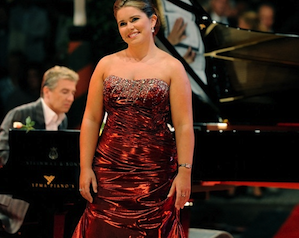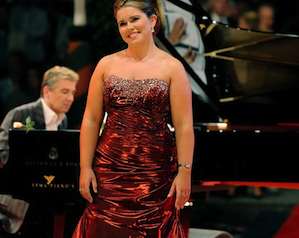
At age 25, two years after two widely touted triumphs at the Bavarian State Opera, the gifted ball of smiling Irish energy known as mezzo-soprano Tara Erraught has embarked on her first North American recital tour. Thanks to the programming acumen of Robert Cole, Weill Hall in the Green Music Center at Sonoma State University nabbed the adorable and extremely personable artist long before she had an opportunity to sing in San Francisco.
Accompanied for the very first time by slim and equally adorable Jonathan Ware, a Juilliard graduate who received the Pianists Prize at the 2011 Wigmore Hall International Song Competition in London, Erraught undertook a challenging program that began with songs by Dvořák, Respighi, Brahms, and Wolf. If the indisputable highlight of the Sunday afternoon recital came in her concluding arias by Handel and Rossini, the bulk of the program did much to clarify her strengths and weaknesses at this point in time.
To these ears, Erraught’s instrument is puzzling and a bit worrisome. That her low range is somewhat shallow and lacking in expression, and her top notes bright and lovely but only briefly dwelt upon, is a limitation shared by many a great artist. More troubling is that, in the middle of her range, her otherwise steady vibrato too often loosens into an obtrusive quasi-wobble where spread trumps tone. This is especially troublesome when she sings softly.
Experience Erraught with eyes open, and you discover a visually captivating storyteller whose delightful facial expressions and arm movements consistently amplify the emotions of her tales. Close your eyes, and you hear tone far more suggestive of a mature woman past her vocal peak than of a young singer on the ascent.
Then ponder the music and text. Dvořák’s Four Songs Op. 82, for example, begin with “Frühling” (Springtime). Similarly, Brahms’ 11 Zigeunerlieder (Gypsy Songs), include several songs that call for fresh, spring-like sound. But when Erraught sang “Wißt ihr, wenn mein Kindchen am allerschönsten ist?” (Do you know when my darling is most beautiful?/ When her sweet mouth teases and laughs and kisses), she sounded not in the least as if she possessed or could paint a sweet, rosy mouth.
Experience Erraught with eyes open, and you discover a visually captivating storyteller whose delightful facial expressions and arm movements consistently amplify the emotions of her tales.
Indeed, her tone varied little. Some attempts to soften and sweeten succeeded, but others yielded to the loosened vibrato and midrange “whuuh” that sounded anything but fresh. This, perhaps, mattered less to audience members whose engagement was mainly visual, because Erraught is truly a visually engaging singer. But to those looking for the union between text and tone that is the hallmark of a great recitalist, she came up short.
Addressing the audience after intermission, Erraught claimed the six Mörike Lieder by Hugo Wolf she was about to sing were some of her favorites. Truly she relished their stories. But did she capture the ecstatic welcome of springtime in “Er ist’s!” (It’s Spring!), the despair of “Das verlassene Mägdlein” (The Deserted Damsel), or the sprightly teasing tone essential to “Nixe Binsefuß (The Mermaid Rushfoot)? You know the answer.
True, her legato was seamless, save when the wobble intruded, her enunciation clear, and her involvement genuine and complete. “Verborgenheit” (Seclusion), the most successful of the songs, was performed with great sincerity and deep understanding of the suffering that even love cannot erase. But even here, when text evoked world-weariness, Erraught came up short.
It would be nice to be able to fully evaluate Ware’s gift as an accompanist. He certainly seemed aligned with Erraught, and more than capable of evoking whatever sentiment a song called for. His fast playing was especially fluid. Alas, with the piano lid open only quarter stick, his instrument’s colors and a range of expression were truncated. Why didn’t Erraught allow him to open the piano further? Was she afraid that she might be upstaged by the instrument’s greater tonal palette?
Erraught’s potential as a song recitalist shone most in her first encore ... the single overarching sentiment fit perfectly with her voice and personality, and the accent, of course, was spot on.
Saved for the end was Erraught’s great gift of coloratura. Handel’s thrilling virtuoso showpiece, “Dopo notte” (After a dark and terrible night) from Ariodante, as well as Rossini’s “Una voce poco fa” from The Barber of Seville and “Nacqui all’affanno … Non più mesta” from La Cenerentola were ideally suited to her strengths at this point in time. Terrifying coloratura runs challenged her not, with every note clearly articulated and evenly produced. Lows were the strongest of the afternoon, and highs displayed considerable volume and tonal bloom.
But even here, limitations emerged. Climactic high notes were held but briefly, and the descent in both Rossini numbers came up slightly sharp. Also evident was a tendency to replicate some of Cecilia Bartoli’s most engaging stage shtick without tapping into the vocal and creative brilliance that make Bartoli’s shtick such a joy.
Erraught’s potential as a song recitalist shone most in her first encore, “Danny Boy.” The song’s single overarching sentiment fit perfectly with her voice and personality, and the accent, of course, was spot on. Despite her limitations, it was just lovely.
As, I am convinced, is Erraught herself. Catapulted to fame at a very young age, it is quite possible that, with additional training and the passage of time, she will conquer her vocal problems and develop greater interpretive acumen. If the wobble gets under control, and more colors and freshness emerge in the voice, she will have far more than a fighting chance to fulfill her considerable potential.

